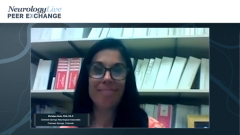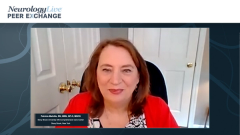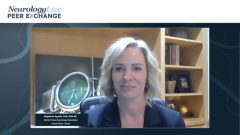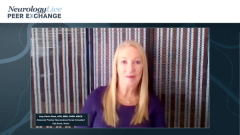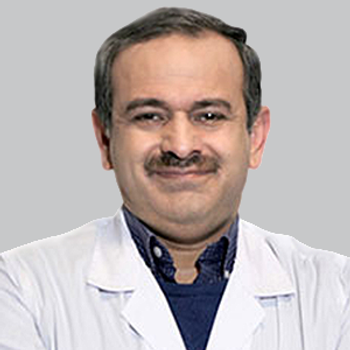
Selecting an S1P Modulator for Relapsing MS
Variables that impact which S1P receptor modulator is selected as treatment for relapsing multiple sclerosis.
Episodes in this series

Transcript:
Bryan Walker, MHS, PA-C: I’d be interested to learn from the group if they have a favorite S1P [sphingosine-1-phosphate] drug, or now that we have a few of these different medications available to us with the same type of mechanism of action, how do you decide which one you’re going to use in a particular patient? I often have a hard time with that. I hate to say it, but sometimes we must deal with the patient’s formulary based on their insurance, but I’d be interested in hearing your thoughts.
Patricia Melville, RN, MSN, NP-C, MSCN: I’ll jump in with this. With fingolimod, we’re using less and less of it because that does require that 6-hour FDO [first-dose observation]. And during the pandemic, patients haven’t wanted to come in and sit in our office for 6 hours, nor do they want to have a stranger come into their home and sit at their kitchen table with them for 6 hours. That option has fallen out of favor. True confession, I haven’t used ponesimod yet; I vacillate between siponimod and ozanimod. The patient’s comorbidities need to be considered, concomitant medications go into it, and as you said, Bryan, unfortunately we have to deal with the insurance restrictions. That’s where I’m at.
Amy Perrin Ross, APN, MSN, CNRN, MSCN: Christen, how about you?
Christen Kutz, PhD, PA-C: If I had a patient for whom I felt as though an S1P receptor modulator was the appropriate treatment, I’ve had some good success with ozanimod because the cardiac monitoring is not required unless there’s an underlying condition. That’s No. 1. The OCT [optical coherence tomography] testing is not required either unless a patient is diabetic or has a history of uveitis. You don’t have to do the genetic ASIP testing, the CYP2C9 testing. I’ve had good experience just onboarding quicker with that medication compared to the other S1Ps.
Amy Perrin Ross, APN, MSN, CNRN, MSCN:We’ve had similar experiences with ponesimod in our practice as well. Sometimes it’s more about what you can do and what you have to do, and how many hurdles you have to jump, not just you, but your patients as well. It helps us weigh one side or the other. Stephanie, did you have a comment?
Stephanie Agrella, PhD, APN-BC: I would agree with both Pat and Christen. We haven’t had an opportunity to utilize ponesimod either, and I would say that right now the S1P of choice, barring formulary, has been ozanimod and it’s because of the ease of starting someone on it. With fingolimod, in the beginning it was the only S1P we had, and we had a good amount of difficulty initially getting all the testing done that was required. And of course, when we’re trying to get someone started on a medication, we want to try to keep the momentum going, and with the eye examination, the EKG [electrocardiogram], and then the FDO, sometimes there were some hiccups there and we had delays in getting people treated or getting them onboard. That’s one thing that we are not seeing as an issue with ozanimod; again, it’s dependent upon insurance coverage and things of that nature, but for the most part, that’s my go-to right now.
Bryan Walker, MHS, PA-C: One more point regarding the newer S1P agents is, I don’t get concerned if for whatever reason, and its usually insurance-related, there’s a lapse in treatment. It was pretty hard and fast that you “should do another FDO” if a patient was off of fingolimod for greater than 2 weeks. There’s more flexibility there with some of the new S1P receptor drugs, and again, that kind of goes back more toward the labeling and what the FDA had required in their label, rather than the real pharmacology and physiology with regard to the medications.
Amy Perrin Ross, APN, MSN, CNRN, MSCN: I agree, Bryan, and we would like to be more flexible, but what we’re getting pushback on is from the pharmacies. They’re not willing to redispense a drug unless we can show that they’ve had poor titration, or they’ve had this or that or whatever. That’s one of our issues.
Stephanie Agrella, PhD, APN-BC: One of the advantages that ponesimod does offer to us as providers is its fast washout, especially in the setting of those patients who might be attempting pregnancy. That’s one thing that we should also keep in mind. And as you all know, with fingolimod the washout is a couple of months, and then with ozanimod it’s 3 months. With ponesimod, as far as advantages go, that’s one thing that is a real highlight for that particular therapy for many of our patients who, as you all know, are in that prime age, 25 to 35 years of age, and they’re wanting to attempt pregnancies.
Amy Perrin Ross, APN, MSN, CNRN, MSCN:You bring up a good point, Stephanie. That’s something I look at in our practice as well. For whatever reason in our practice, we seem to have a lot of people who find themselves pregnant and don’t know how that happened. And as a health care provider, it’s not my job to inform them, but I feel better about something that I know is going to wash out in a quicker fashion than some of the other S1Ps.
Thank you all so much. I would like to thank this wonderful panel, Christen Kutz, Stephanie Agrella, Bryan Walker, and Patricia Melville for this wonderful discussion. I’d like to thank you, as an audience, for watching NeurologyLive® Peer Exchange. If you enjoyed the content, I suggest that you subscribe to the NeurologyLive® newsletters to receive information about upcoming Peer Exchange segments and other content available to you. Thank you all so much.
Transcript edited for clarity.
Newsletter
Keep your finger on the pulse of neurology—subscribe to NeurologyLive for expert interviews, new data, and breakthrough treatment updates.


